BTEC HNC Business Unit 4: Management & Operations Report - Ikea
VerifiedAdded on 2023/01/13
|14
|3920
|47
Report
AI Summary
This report provides an in-depth analysis of management and operations, using Ikea as a case study. It begins by defining operations management and exploring the roles of leaders and managers in different situations, supported by various leadership theories such as situational, systems, and contingency leadership. The report then delves into the strengths and weaknesses of different approaches to workplace situations, such as conflict resolution. Furthermore, it examines key approaches to operations management, including Total Quality Management (TQM), Just-in-Time (JIT), and Kaizen, highlighting the roles of leaders and managers within each approach. The report emphasizes the importance of operations management in achieving business objectives, discussing its value in enhancing product quality, reducing waste, and improving customer satisfaction. Finally, it explores factors impacting operational management and decision-making, and how leaders and managers can improve operational efficiencies to meet business objectives, concluding with an overview of how these factors affect the business environment and the wider community.
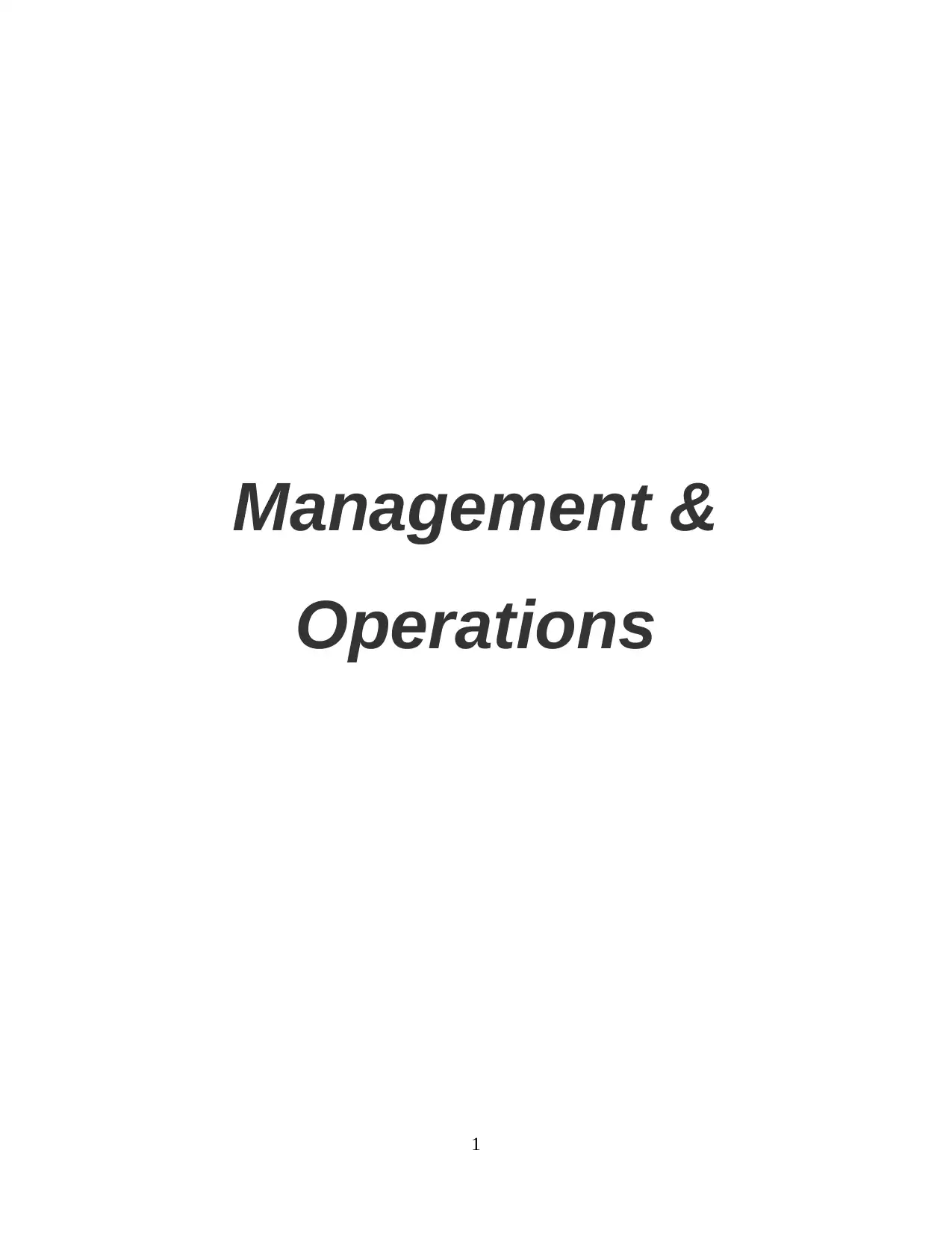
Management &
Operations
1
Operations
1
Secure Best Marks with AI Grader
Need help grading? Try our AI Grader for instant feedback on your assignments.
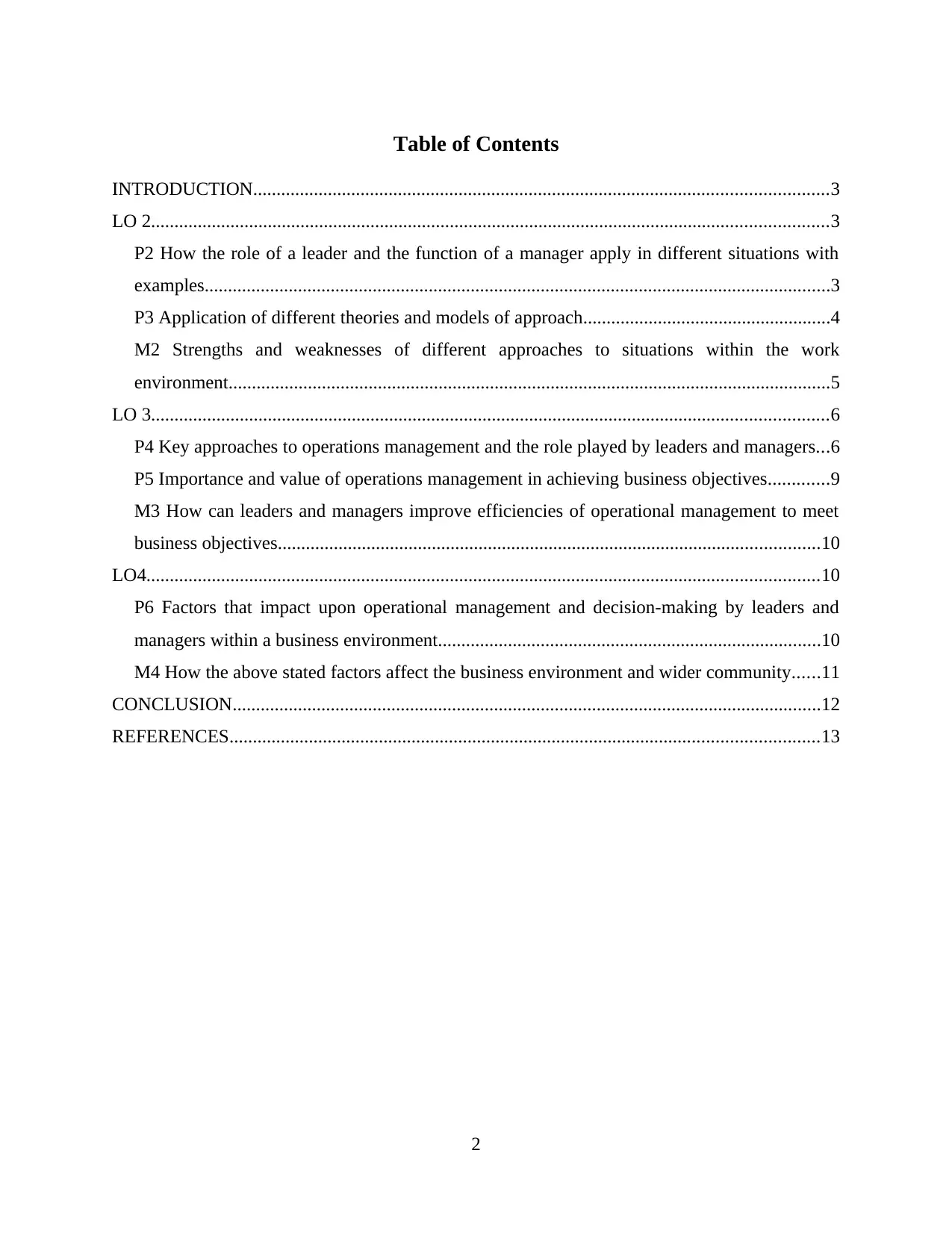
Table of Contents
INTRODUCTION...........................................................................................................................3
LO 2.................................................................................................................................................3
P2 How the role of a leader and the function of a manager apply in different situations with
examples......................................................................................................................................3
P3 Application of different theories and models of approach.....................................................4
M2 Strengths and weaknesses of different approaches to situations within the work
environment.................................................................................................................................5
LO 3.................................................................................................................................................6
P4 Key approaches to operations management and the role played by leaders and managers...6
P5 Importance and value of operations management in achieving business objectives.............9
M3 How can leaders and managers improve efficiencies of operational management to meet
business objectives....................................................................................................................10
LO4................................................................................................................................................10
P6 Factors that impact upon operational management and decision-making by leaders and
managers within a business environment..................................................................................10
M4 How the above stated factors affect the business environment and wider community......11
CONCLUSION..............................................................................................................................12
REFERENCES..............................................................................................................................13
2
INTRODUCTION...........................................................................................................................3
LO 2.................................................................................................................................................3
P2 How the role of a leader and the function of a manager apply in different situations with
examples......................................................................................................................................3
P3 Application of different theories and models of approach.....................................................4
M2 Strengths and weaknesses of different approaches to situations within the work
environment.................................................................................................................................5
LO 3.................................................................................................................................................6
P4 Key approaches to operations management and the role played by leaders and managers...6
P5 Importance and value of operations management in achieving business objectives.............9
M3 How can leaders and managers improve efficiencies of operational management to meet
business objectives....................................................................................................................10
LO4................................................................................................................................................10
P6 Factors that impact upon operational management and decision-making by leaders and
managers within a business environment..................................................................................10
M4 How the above stated factors affect the business environment and wider community......11
CONCLUSION..............................................................................................................................12
REFERENCES..............................................................................................................................13
2
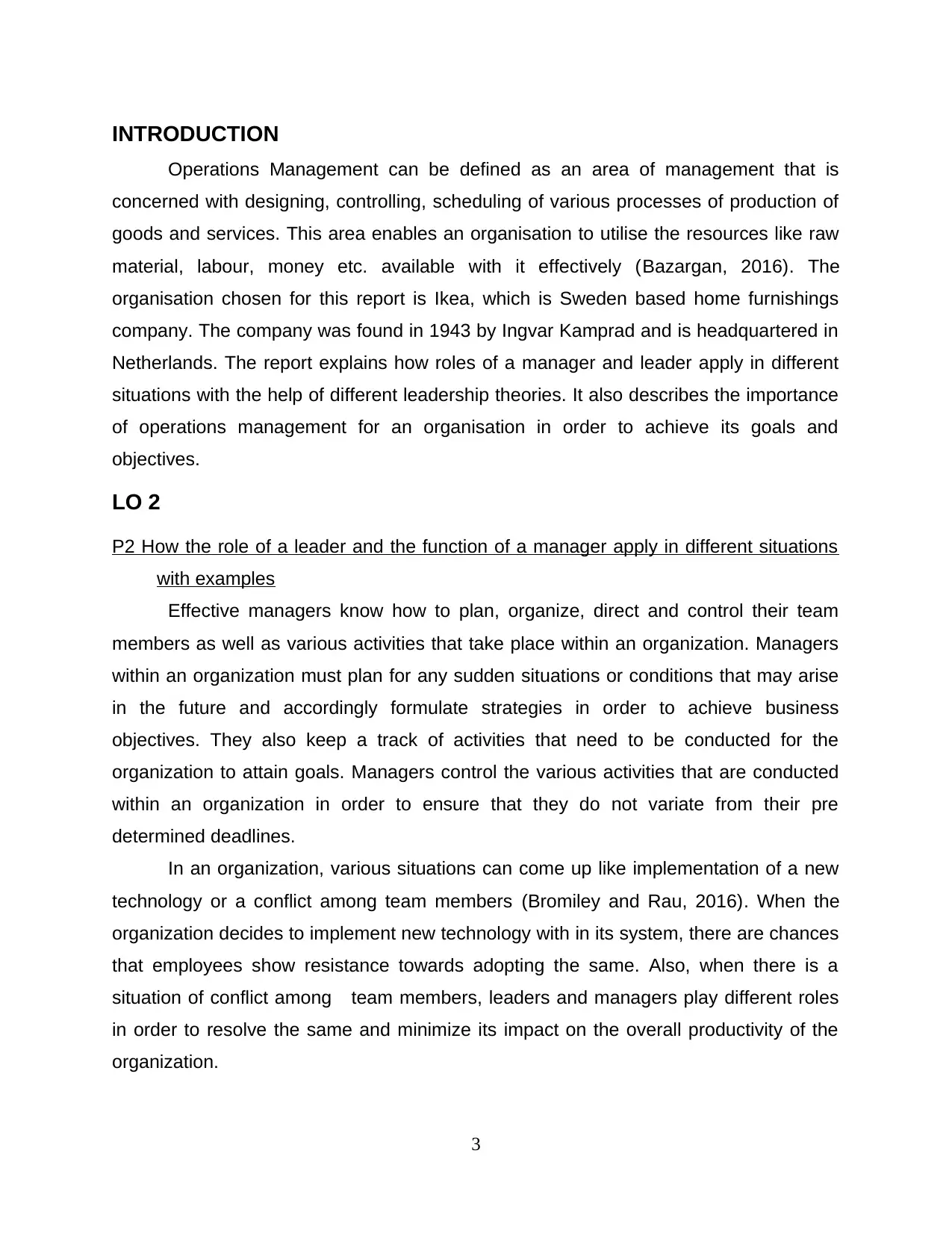
INTRODUCTION
Operations Management can be defined as an area of management that is
concerned with designing, controlling, scheduling of various processes of production of
goods and services. This area enables an organisation to utilise the resources like raw
material, labour, money etc. available with it effectively (Bazargan, 2016). The
organisation chosen for this report is Ikea, which is Sweden based home furnishings
company. The company was found in 1943 by Ingvar Kamprad and is headquartered in
Netherlands. The report explains how roles of a manager and leader apply in different
situations with the help of different leadership theories. It also describes the importance
of operations management for an organisation in order to achieve its goals and
objectives.
LO 2
P2 How the role of a leader and the function of a manager apply in different situations
with examples
Effective managers know how to plan, organize, direct and control their team
members as well as various activities that take place within an organization. Managers
within an organization must plan for any sudden situations or conditions that may arise
in the future and accordingly formulate strategies in order to achieve business
objectives. They also keep a track of activities that need to be conducted for the
organization to attain goals. Managers control the various activities that are conducted
within an organization in order to ensure that they do not variate from their pre
determined deadlines.
In an organization, various situations can come up like implementation of a new
technology or a conflict among team members (Bromiley and Rau, 2016). When the
organization decides to implement new technology with in its system, there are chances
that employees show resistance towards adopting the same. Also, when there is a
situation of conflict among team members, leaders and managers play different roles
in order to resolve the same and minimize its impact on the overall productivity of the
organization.
3
Operations Management can be defined as an area of management that is
concerned with designing, controlling, scheduling of various processes of production of
goods and services. This area enables an organisation to utilise the resources like raw
material, labour, money etc. available with it effectively (Bazargan, 2016). The
organisation chosen for this report is Ikea, which is Sweden based home furnishings
company. The company was found in 1943 by Ingvar Kamprad and is headquartered in
Netherlands. The report explains how roles of a manager and leader apply in different
situations with the help of different leadership theories. It also describes the importance
of operations management for an organisation in order to achieve its goals and
objectives.
LO 2
P2 How the role of a leader and the function of a manager apply in different situations
with examples
Effective managers know how to plan, organize, direct and control their team
members as well as various activities that take place within an organization. Managers
within an organization must plan for any sudden situations or conditions that may arise
in the future and accordingly formulate strategies in order to achieve business
objectives. They also keep a track of activities that need to be conducted for the
organization to attain goals. Managers control the various activities that are conducted
within an organization in order to ensure that they do not variate from their pre
determined deadlines.
In an organization, various situations can come up like implementation of a new
technology or a conflict among team members (Bromiley and Rau, 2016). When the
organization decides to implement new technology with in its system, there are chances
that employees show resistance towards adopting the same. Also, when there is a
situation of conflict among team members, leaders and managers play different roles
in order to resolve the same and minimize its impact on the overall productivity of the
organization.
3
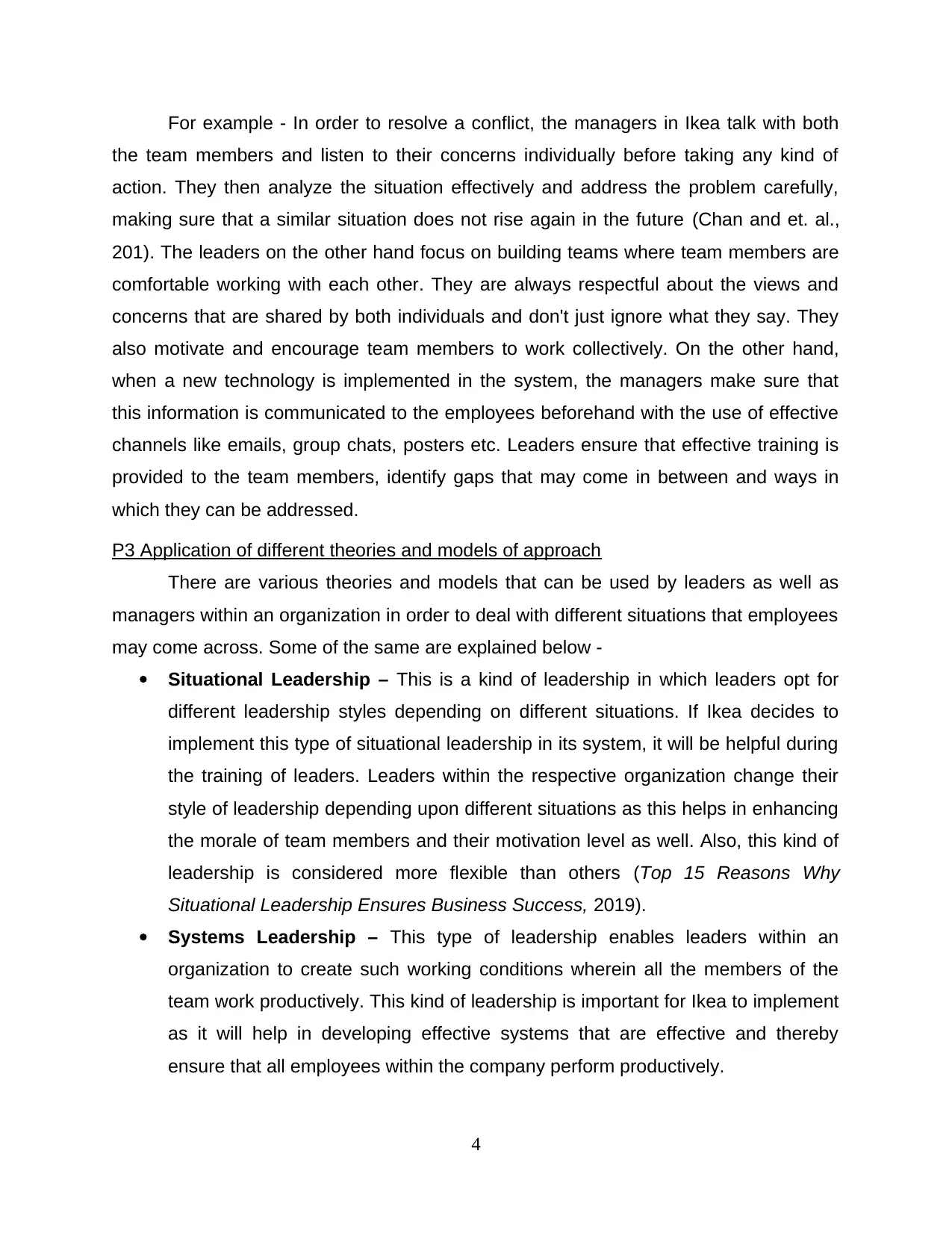
For example - In order to resolve a conflict, the managers in Ikea talk with both
the team members and listen to their concerns individually before taking any kind of
action. They then analyze the situation effectively and address the problem carefully,
making sure that a similar situation does not rise again in the future (Chan and et. al.,
201). The leaders on the other hand focus on building teams where team members are
comfortable working with each other. They are always respectful about the views and
concerns that are shared by both individuals and don't just ignore what they say. They
also motivate and encourage team members to work collectively. On the other hand,
when a new technology is implemented in the system, the managers make sure that
this information is communicated to the employees beforehand with the use of effective
channels like emails, group chats, posters etc. Leaders ensure that effective training is
provided to the team members, identify gaps that may come in between and ways in
which they can be addressed.
P3 Application of different theories and models of approach
There are various theories and models that can be used by leaders as well as
managers within an organization in order to deal with different situations that employees
may come across. Some of the same are explained below -
Situational Leadership – This is a kind of leadership in which leaders opt for
different leadership styles depending on different situations. If Ikea decides to
implement this type of situational leadership in its system, it will be helpful during
the training of leaders. Leaders within the respective organization change their
style of leadership depending upon different situations as this helps in enhancing
the morale of team members and their motivation level as well. Also, this kind of
leadership is considered more flexible than others (Top 15 Reasons Why
Situational Leadership Ensures Business Success, 2019).
Systems Leadership – This type of leadership enables leaders within an
organization to create such working conditions wherein all the members of the
team work productively. This kind of leadership is important for Ikea to implement
as it will help in developing effective systems that are effective and thereby
ensure that all employees within the company perform productively.
4
the team members and listen to their concerns individually before taking any kind of
action. They then analyze the situation effectively and address the problem carefully,
making sure that a similar situation does not rise again in the future (Chan and et. al.,
201). The leaders on the other hand focus on building teams where team members are
comfortable working with each other. They are always respectful about the views and
concerns that are shared by both individuals and don't just ignore what they say. They
also motivate and encourage team members to work collectively. On the other hand,
when a new technology is implemented in the system, the managers make sure that
this information is communicated to the employees beforehand with the use of effective
channels like emails, group chats, posters etc. Leaders ensure that effective training is
provided to the team members, identify gaps that may come in between and ways in
which they can be addressed.
P3 Application of different theories and models of approach
There are various theories and models that can be used by leaders as well as
managers within an organization in order to deal with different situations that employees
may come across. Some of the same are explained below -
Situational Leadership – This is a kind of leadership in which leaders opt for
different leadership styles depending on different situations. If Ikea decides to
implement this type of situational leadership in its system, it will be helpful during
the training of leaders. Leaders within the respective organization change their
style of leadership depending upon different situations as this helps in enhancing
the morale of team members and their motivation level as well. Also, this kind of
leadership is considered more flexible than others (Top 15 Reasons Why
Situational Leadership Ensures Business Success, 2019).
Systems Leadership – This type of leadership enables leaders within an
organization to create such working conditions wherein all the members of the
team work productively. This kind of leadership is important for Ikea to implement
as it will help in developing effective systems that are effective and thereby
ensure that all employees within the company perform productively.
4
Secure Best Marks with AI Grader
Need help grading? Try our AI Grader for instant feedback on your assignments.
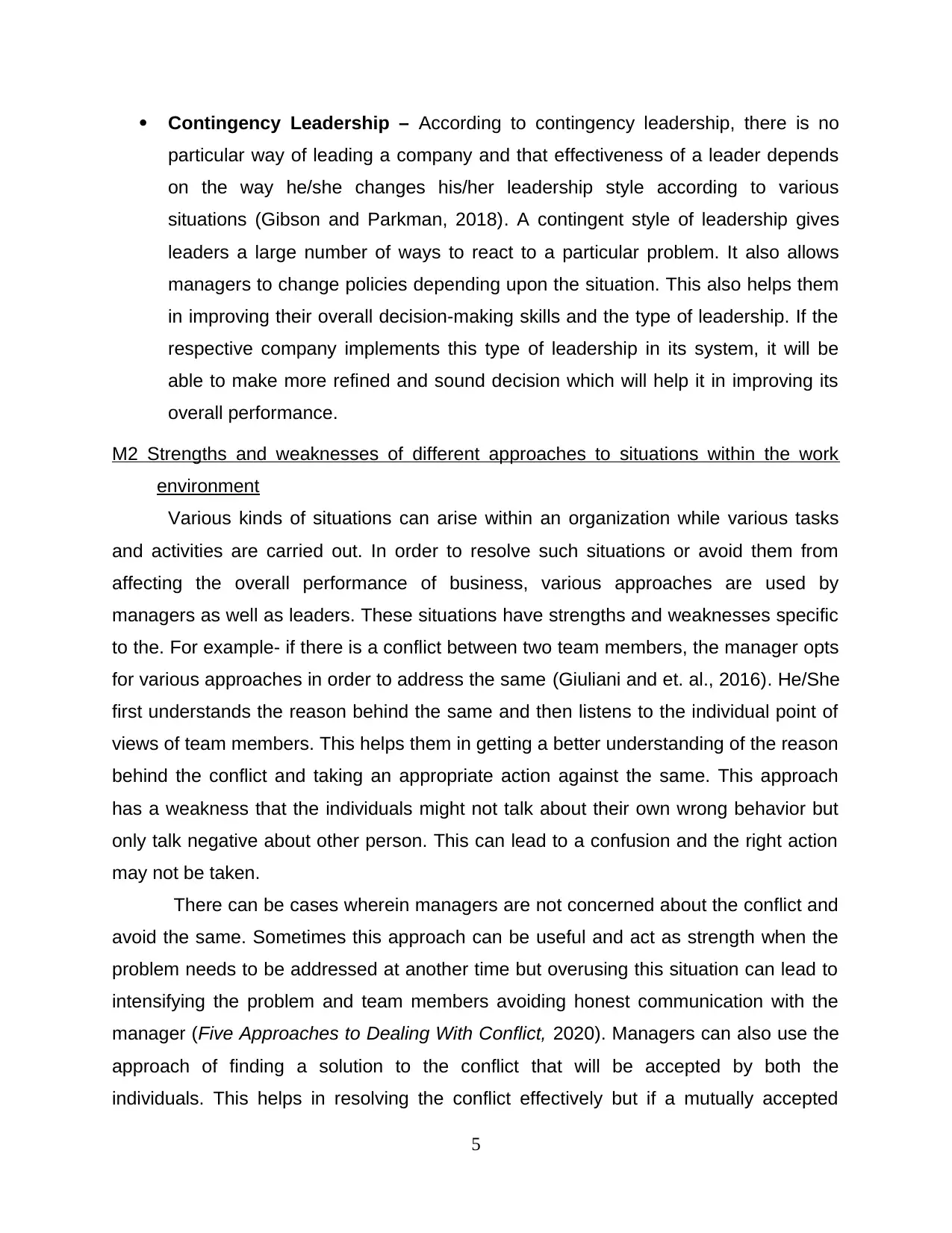
Contingency Leadership – According to contingency leadership, there is no
particular way of leading a company and that effectiveness of a leader depends
on the way he/she changes his/her leadership style according to various
situations (Gibson and Parkman, 2018). A contingent style of leadership gives
leaders a large number of ways to react to a particular problem. It also allows
managers to change policies depending upon the situation. This also helps them
in improving their overall decision-making skills and the type of leadership. If the
respective company implements this type of leadership in its system, it will be
able to make more refined and sound decision which will help it in improving its
overall performance.
M2 Strengths and weaknesses of different approaches to situations within the work
environment
Various kinds of situations can arise within an organization while various tasks
and activities are carried out. In order to resolve such situations or avoid them from
affecting the overall performance of business, various approaches are used by
managers as well as leaders. These situations have strengths and weaknesses specific
to the. For example- if there is a conflict between two team members, the manager opts
for various approaches in order to address the same (Giuliani and et. al., 2016). He/She
first understands the reason behind the same and then listens to the individual point of
views of team members. This helps them in getting a better understanding of the reason
behind the conflict and taking an appropriate action against the same. This approach
has a weakness that the individuals might not talk about their own wrong behavior but
only talk negative about other person. This can lead to a confusion and the right action
may not be taken.
There can be cases wherein managers are not concerned about the conflict and
avoid the same. Sometimes this approach can be useful and act as strength when the
problem needs to be addressed at another time but overusing this situation can lead to
intensifying the problem and team members avoiding honest communication with the
manager (Five Approaches to Dealing With Conflict, 2020). Managers can also use the
approach of finding a solution to the conflict that will be accepted by both the
individuals. This helps in resolving the conflict effectively but if a mutually accepted
5
particular way of leading a company and that effectiveness of a leader depends
on the way he/she changes his/her leadership style according to various
situations (Gibson and Parkman, 2018). A contingent style of leadership gives
leaders a large number of ways to react to a particular problem. It also allows
managers to change policies depending upon the situation. This also helps them
in improving their overall decision-making skills and the type of leadership. If the
respective company implements this type of leadership in its system, it will be
able to make more refined and sound decision which will help it in improving its
overall performance.
M2 Strengths and weaknesses of different approaches to situations within the work
environment
Various kinds of situations can arise within an organization while various tasks
and activities are carried out. In order to resolve such situations or avoid them from
affecting the overall performance of business, various approaches are used by
managers as well as leaders. These situations have strengths and weaknesses specific
to the. For example- if there is a conflict between two team members, the manager opts
for various approaches in order to address the same (Giuliani and et. al., 2016). He/She
first understands the reason behind the same and then listens to the individual point of
views of team members. This helps them in getting a better understanding of the reason
behind the conflict and taking an appropriate action against the same. This approach
has a weakness that the individuals might not talk about their own wrong behavior but
only talk negative about other person. This can lead to a confusion and the right action
may not be taken.
There can be cases wherein managers are not concerned about the conflict and
avoid the same. Sometimes this approach can be useful and act as strength when the
problem needs to be addressed at another time but overusing this situation can lead to
intensifying the problem and team members avoiding honest communication with the
manager (Five Approaches to Dealing With Conflict, 2020). Managers can also use the
approach of finding a solution to the conflict that will be accepted by both the
individuals. This helps in resolving the conflict effectively but if a mutually accepted
5
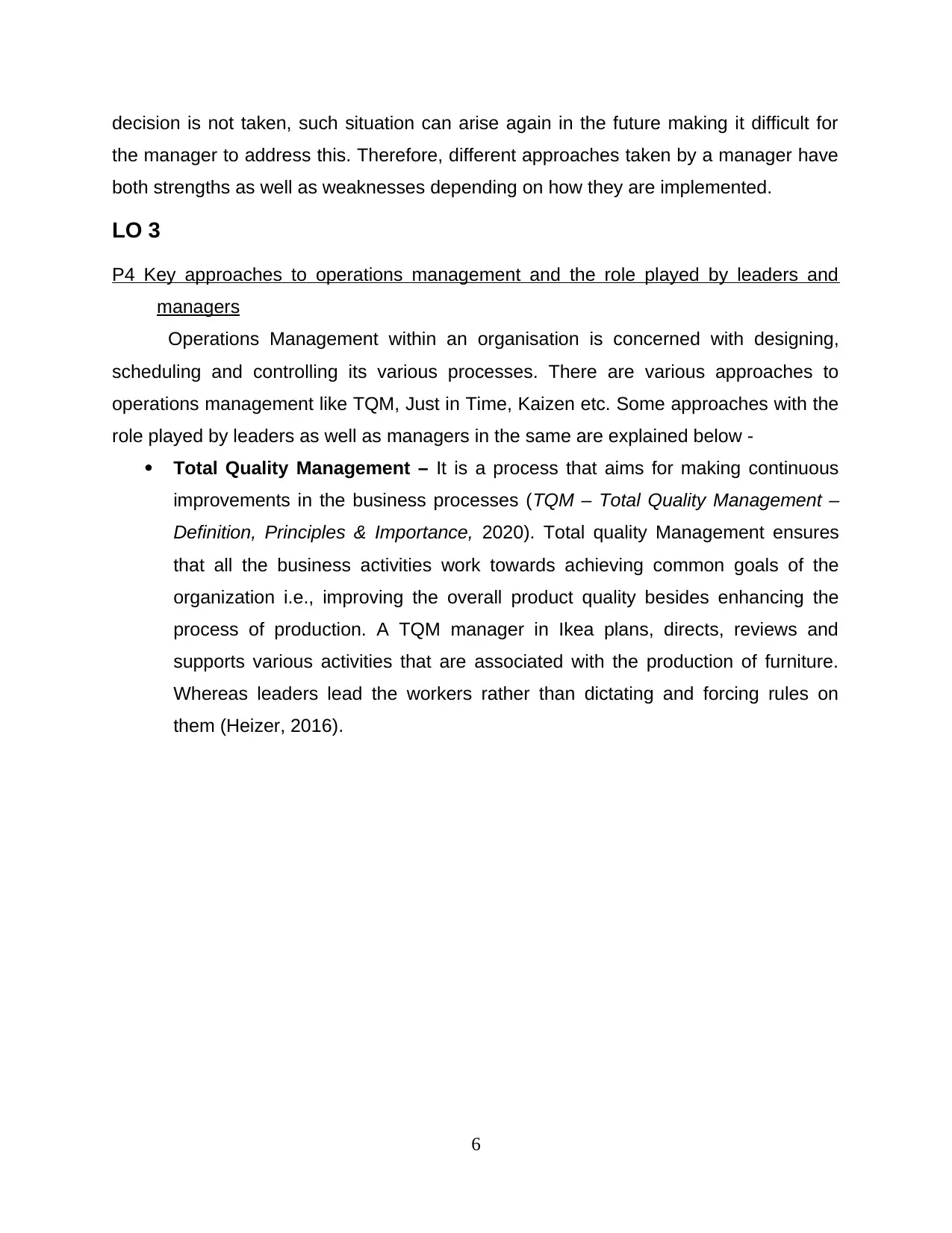
decision is not taken, such situation can arise again in the future making it difficult for
the manager to address this. Therefore, different approaches taken by a manager have
both strengths as well as weaknesses depending on how they are implemented.
LO 3
P4 Key approaches to operations management and the role played by leaders and
managers
Operations Management within an organisation is concerned with designing,
scheduling and controlling its various processes. There are various approaches to
operations management like TQM, Just in Time, Kaizen etc. Some approaches with the
role played by leaders as well as managers in the same are explained below -
Total Quality Management – It is a process that aims for making continuous
improvements in the business processes (TQM – Total Quality Management –
Definition, Principles & Importance, 2020). Total quality Management ensures
that all the business activities work towards achieving common goals of the
organization i.e., improving the overall product quality besides enhancing the
process of production. A TQM manager in Ikea plans, directs, reviews and
supports various activities that are associated with the production of furniture.
Whereas leaders lead the workers rather than dictating and forcing rules on
them (Heizer, 2016).
6
the manager to address this. Therefore, different approaches taken by a manager have
both strengths as well as weaknesses depending on how they are implemented.
LO 3
P4 Key approaches to operations management and the role played by leaders and
managers
Operations Management within an organisation is concerned with designing,
scheduling and controlling its various processes. There are various approaches to
operations management like TQM, Just in Time, Kaizen etc. Some approaches with the
role played by leaders as well as managers in the same are explained below -
Total Quality Management – It is a process that aims for making continuous
improvements in the business processes (TQM – Total Quality Management –
Definition, Principles & Importance, 2020). Total quality Management ensures
that all the business activities work towards achieving common goals of the
organization i.e., improving the overall product quality besides enhancing the
process of production. A TQM manager in Ikea plans, directs, reviews and
supports various activities that are associated with the production of furniture.
Whereas leaders lead the workers rather than dictating and forcing rules on
them (Heizer, 2016).
6
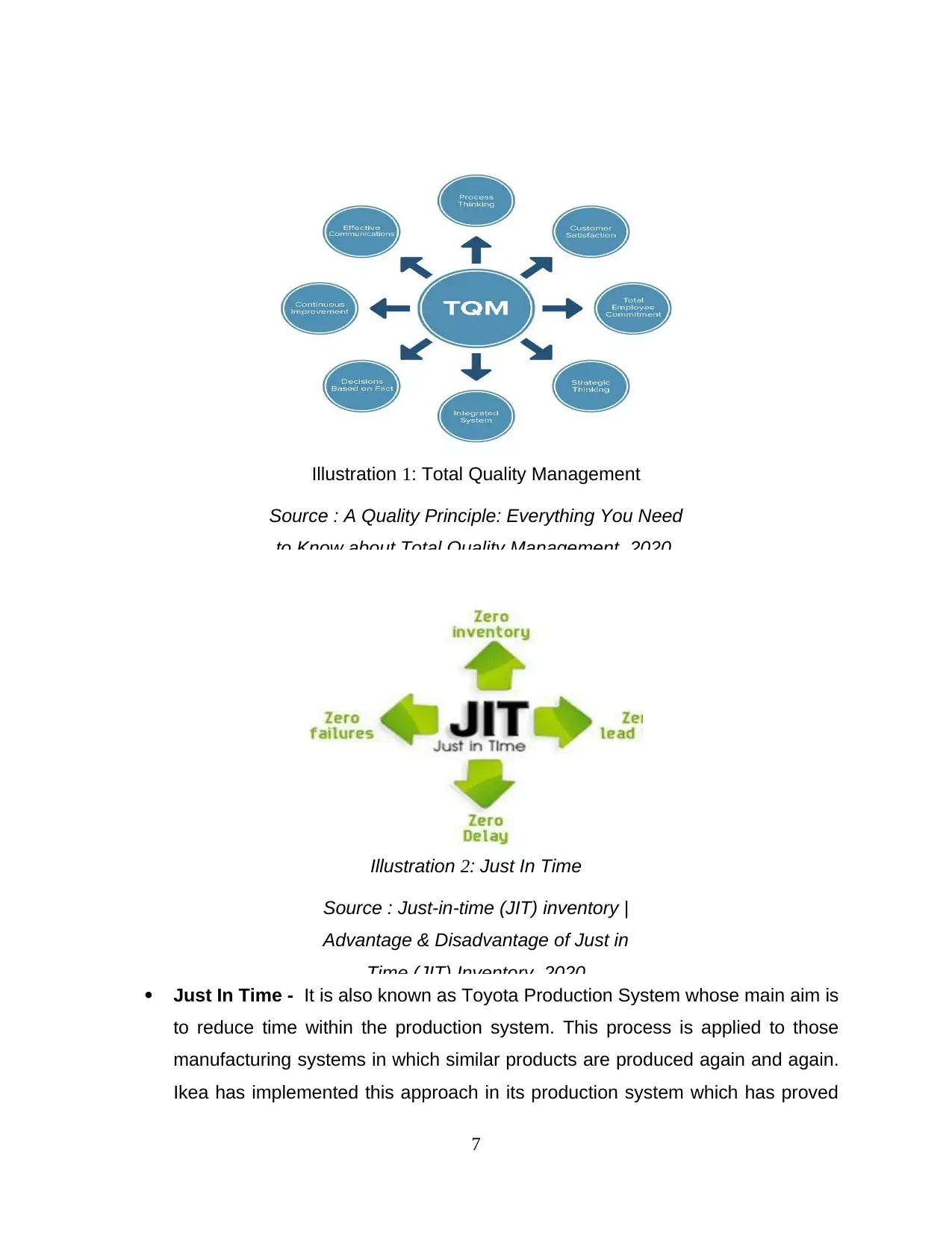
Just In Time - It is also known as Toyota Production System whose main aim is
to reduce time within the production system. This process is applied to those
manufacturing systems in which similar products are produced again and again.
Ikea has implemented this approach in its production system which has proved
7
Illustration 1: Total Quality Management
Source : A Quality Principle: Everything You Need
to Know about Total Quality Management. 2020.
Illustration 2: Just In Time
Source : Just-in-time (JIT) inventory |
Advantage & Disadvantage of Just in
Time (JIT) Inventory. 2020
to reduce time within the production system. This process is applied to those
manufacturing systems in which similar products are produced again and again.
Ikea has implemented this approach in its production system which has proved
7
Illustration 1: Total Quality Management
Source : A Quality Principle: Everything You Need
to Know about Total Quality Management. 2020.
Illustration 2: Just In Time
Source : Just-in-time (JIT) inventory |
Advantage & Disadvantage of Just in
Time (JIT) Inventory. 2020
Paraphrase This Document
Need a fresh take? Get an instant paraphrase of this document with our AI Paraphraser
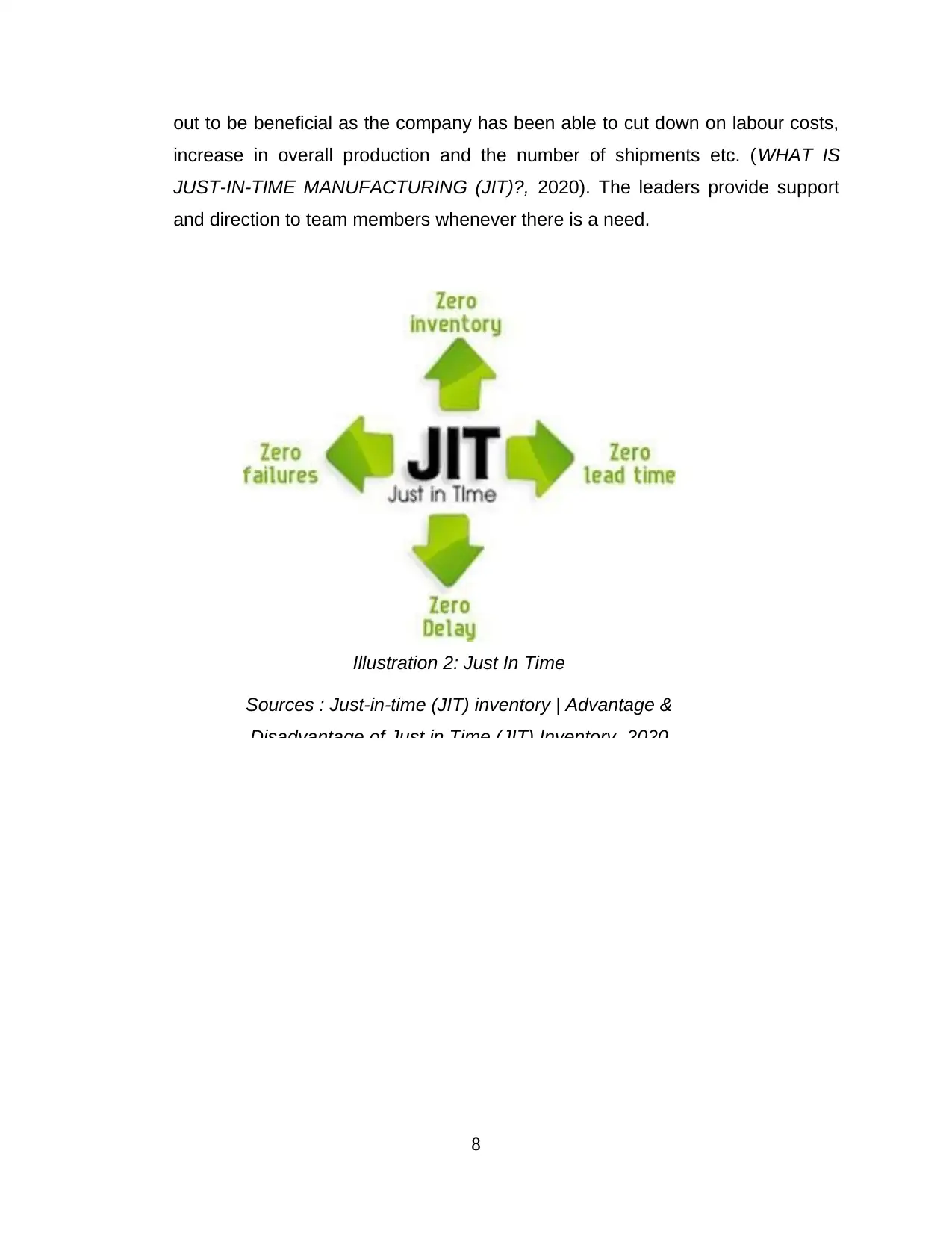
out to be beneficial as the company has been able to cut down on labour costs,
increase in overall production and the number of shipments etc. (WHAT IS
JUST-IN-TIME MANUFACTURING (JIT)?, 2020). The leaders provide support
and direction to team members whenever there is a need.
8
Illustration 2: Just In Time
Sources : Just-in-time (JIT) inventory | Advantage &
Disadvantage of Just in Time (JIT) Inventory. 2020
increase in overall production and the number of shipments etc. (WHAT IS
JUST-IN-TIME MANUFACTURING (JIT)?, 2020). The leaders provide support
and direction to team members whenever there is a need.
8
Illustration 2: Just In Time
Sources : Just-in-time (JIT) inventory | Advantage &
Disadvantage of Just in Time (JIT) Inventory. 2020
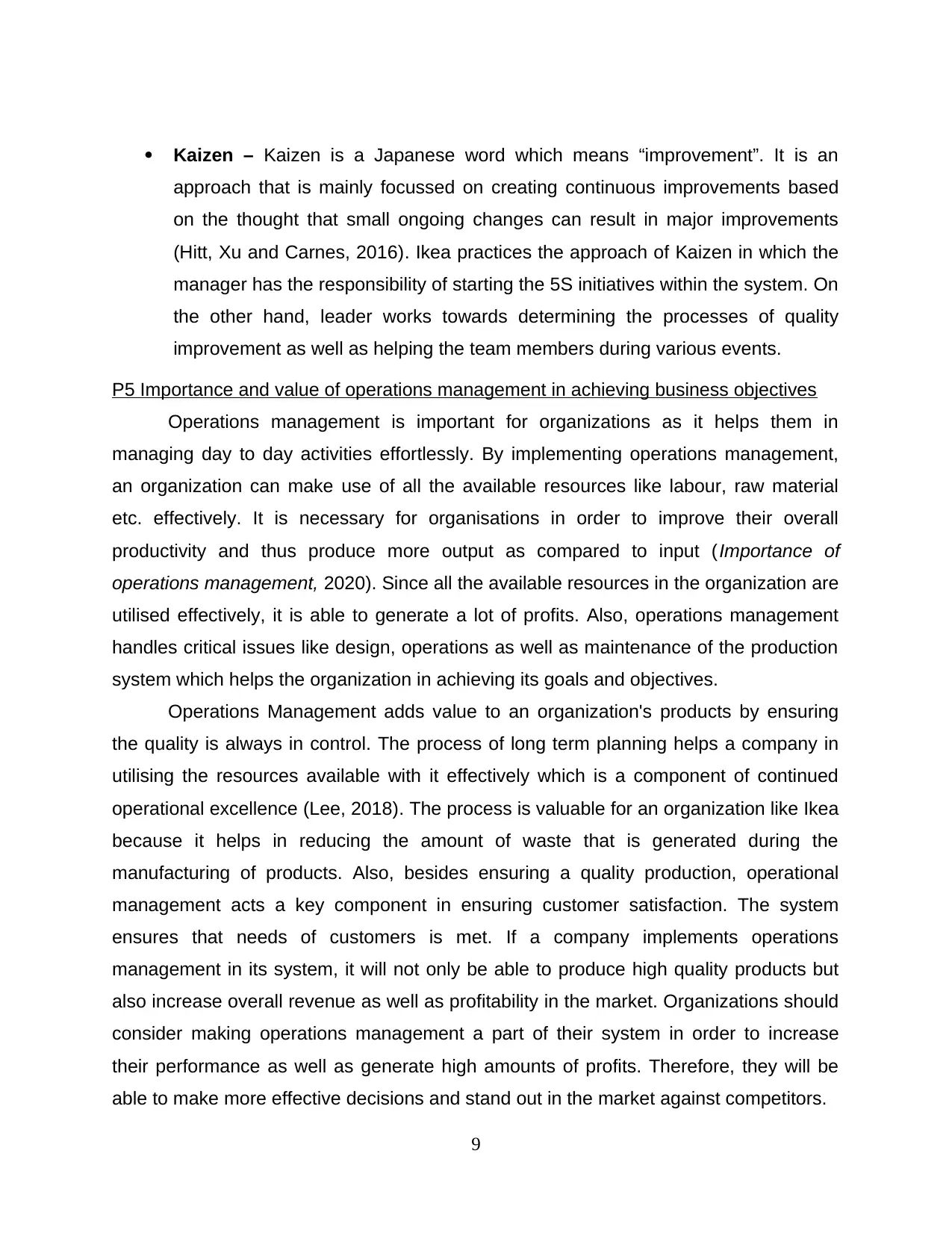
Kaizen – Kaizen is a Japanese word which means “improvement”. It is an
approach that is mainly focussed on creating continuous improvements based
on the thought that small ongoing changes can result in major improvements
(Hitt, Xu and Carnes, 2016). Ikea practices the approach of Kaizen in which the
manager has the responsibility of starting the 5S initiatives within the system. On
the other hand, leader works towards determining the processes of quality
improvement as well as helping the team members during various events.
P5 Importance and value of operations management in achieving business objectives
Operations management is important for organizations as it helps them in
managing day to day activities effortlessly. By implementing operations management,
an organization can make use of all the available resources like labour, raw material
etc. effectively. It is necessary for organisations in order to improve their overall
productivity and thus produce more output as compared to input (Importance of
operations management, 2020). Since all the available resources in the organization are
utilised effectively, it is able to generate a lot of profits. Also, operations management
handles critical issues like design, operations as well as maintenance of the production
system which helps the organization in achieving its goals and objectives.
Operations Management adds value to an organization's products by ensuring
the quality is always in control. The process of long term planning helps a company in
utilising the resources available with it effectively which is a component of continued
operational excellence (Lee, 2018). The process is valuable for an organization like Ikea
because it helps in reducing the amount of waste that is generated during the
manufacturing of products. Also, besides ensuring a quality production, operational
management acts a key component in ensuring customer satisfaction. The system
ensures that needs of customers is met. If a company implements operations
management in its system, it will not only be able to produce high quality products but
also increase overall revenue as well as profitability in the market. Organizations should
consider making operations management a part of their system in order to increase
their performance as well as generate high amounts of profits. Therefore, they will be
able to make more effective decisions and stand out in the market against competitors.
9
approach that is mainly focussed on creating continuous improvements based
on the thought that small ongoing changes can result in major improvements
(Hitt, Xu and Carnes, 2016). Ikea practices the approach of Kaizen in which the
manager has the responsibility of starting the 5S initiatives within the system. On
the other hand, leader works towards determining the processes of quality
improvement as well as helping the team members during various events.
P5 Importance and value of operations management in achieving business objectives
Operations management is important for organizations as it helps them in
managing day to day activities effortlessly. By implementing operations management,
an organization can make use of all the available resources like labour, raw material
etc. effectively. It is necessary for organisations in order to improve their overall
productivity and thus produce more output as compared to input (Importance of
operations management, 2020). Since all the available resources in the organization are
utilised effectively, it is able to generate a lot of profits. Also, operations management
handles critical issues like design, operations as well as maintenance of the production
system which helps the organization in achieving its goals and objectives.
Operations Management adds value to an organization's products by ensuring
the quality is always in control. The process of long term planning helps a company in
utilising the resources available with it effectively which is a component of continued
operational excellence (Lee, 2018). The process is valuable for an organization like Ikea
because it helps in reducing the amount of waste that is generated during the
manufacturing of products. Also, besides ensuring a quality production, operational
management acts a key component in ensuring customer satisfaction. The system
ensures that needs of customers is met. If a company implements operations
management in its system, it will not only be able to produce high quality products but
also increase overall revenue as well as profitability in the market. Organizations should
consider making operations management a part of their system in order to increase
their performance as well as generate high amounts of profits. Therefore, they will be
able to make more effective decisions and stand out in the market against competitors.
9
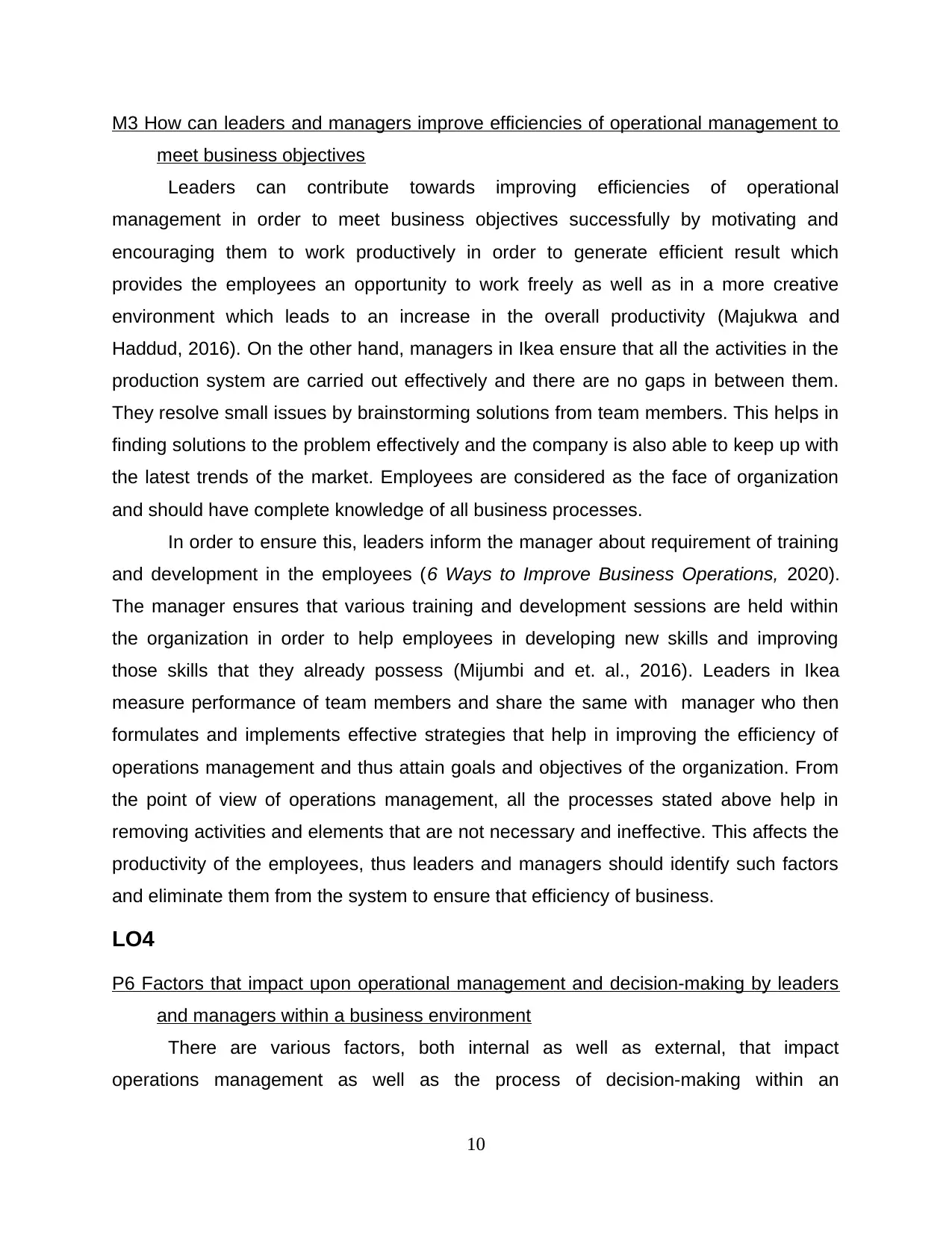
M3 How can leaders and managers improve efficiencies of operational management to
meet business objectives
Leaders can contribute towards improving efficiencies of operational
management in order to meet business objectives successfully by motivating and
encouraging them to work productively in order to generate efficient result which
provides the employees an opportunity to work freely as well as in a more creative
environment which leads to an increase in the overall productivity (Majukwa and
Haddud, 2016). On the other hand, managers in Ikea ensure that all the activities in the
production system are carried out effectively and there are no gaps in between them.
They resolve small issues by brainstorming solutions from team members. This helps in
finding solutions to the problem effectively and the company is also able to keep up with
the latest trends of the market. Employees are considered as the face of organization
and should have complete knowledge of all business processes.
In order to ensure this, leaders inform the manager about requirement of training
and development in the employees (6 Ways to Improve Business Operations, 2020).
The manager ensures that various training and development sessions are held within
the organization in order to help employees in developing new skills and improving
those skills that they already possess (Mijumbi and et. al., 2016). Leaders in Ikea
measure performance of team members and share the same with manager who then
formulates and implements effective strategies that help in improving the efficiency of
operations management and thus attain goals and objectives of the organization. From
the point of view of operations management, all the processes stated above help in
removing activities and elements that are not necessary and ineffective. This affects the
productivity of the employees, thus leaders and managers should identify such factors
and eliminate them from the system to ensure that efficiency of business.
LO4
P6 Factors that impact upon operational management and decision-making by leaders
and managers within a business environment
There are various factors, both internal as well as external, that impact
operations management as well as the process of decision-making within an
10
meet business objectives
Leaders can contribute towards improving efficiencies of operational
management in order to meet business objectives successfully by motivating and
encouraging them to work productively in order to generate efficient result which
provides the employees an opportunity to work freely as well as in a more creative
environment which leads to an increase in the overall productivity (Majukwa and
Haddud, 2016). On the other hand, managers in Ikea ensure that all the activities in the
production system are carried out effectively and there are no gaps in between them.
They resolve small issues by brainstorming solutions from team members. This helps in
finding solutions to the problem effectively and the company is also able to keep up with
the latest trends of the market. Employees are considered as the face of organization
and should have complete knowledge of all business processes.
In order to ensure this, leaders inform the manager about requirement of training
and development in the employees (6 Ways to Improve Business Operations, 2020).
The manager ensures that various training and development sessions are held within
the organization in order to help employees in developing new skills and improving
those skills that they already possess (Mijumbi and et. al., 2016). Leaders in Ikea
measure performance of team members and share the same with manager who then
formulates and implements effective strategies that help in improving the efficiency of
operations management and thus attain goals and objectives of the organization. From
the point of view of operations management, all the processes stated above help in
removing activities and elements that are not necessary and ineffective. This affects the
productivity of the employees, thus leaders and managers should identify such factors
and eliminate them from the system to ensure that efficiency of business.
LO4
P6 Factors that impact upon operational management and decision-making by leaders
and managers within a business environment
There are various factors, both internal as well as external, that impact
operations management as well as the process of decision-making within an
10
Secure Best Marks with AI Grader
Need help grading? Try our AI Grader for instant feedback on your assignments.
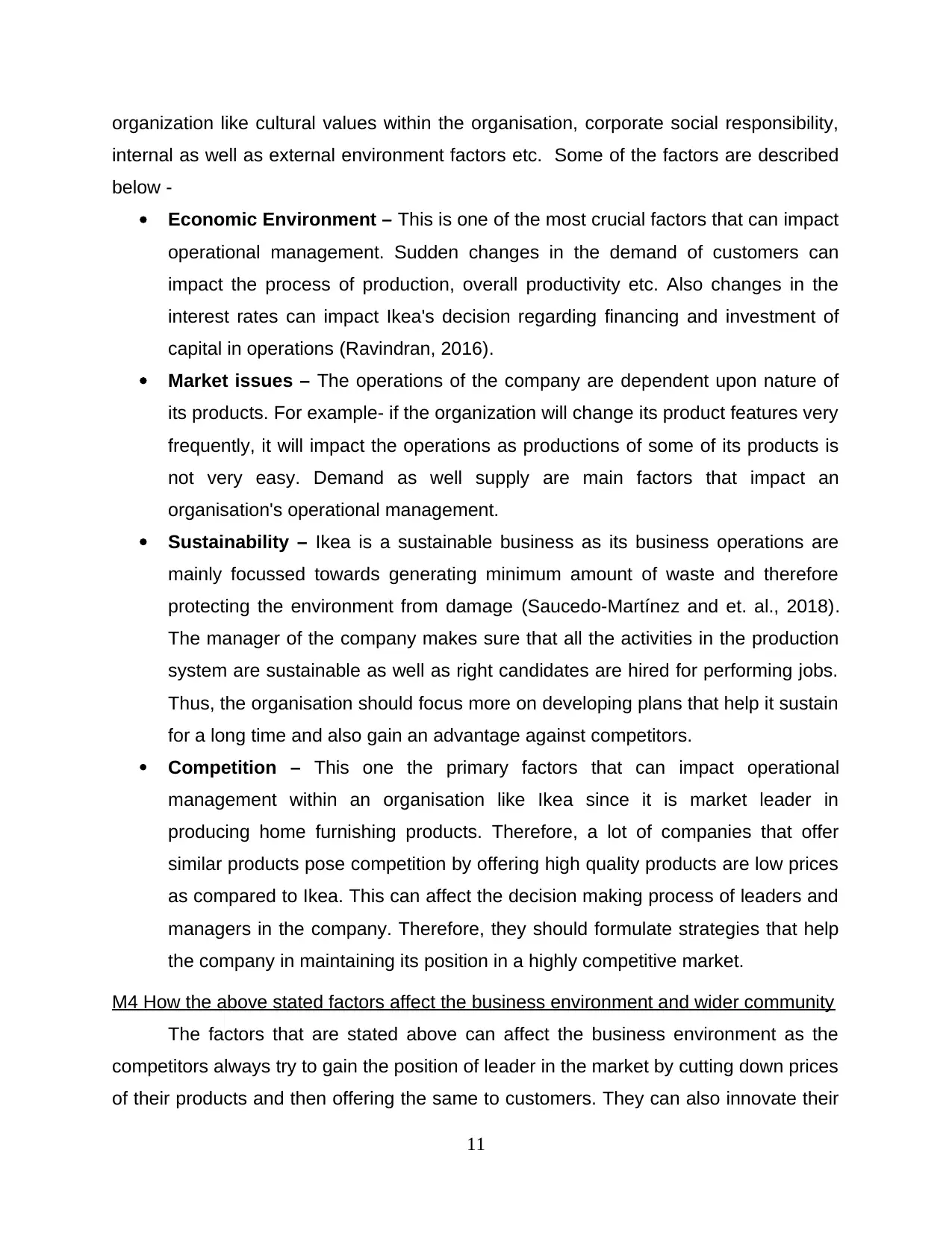
organization like cultural values within the organisation, corporate social responsibility,
internal as well as external environment factors etc. Some of the factors are described
below -
Economic Environment – This is one of the most crucial factors that can impact
operational management. Sudden changes in the demand of customers can
impact the process of production, overall productivity etc. Also changes in the
interest rates can impact Ikea's decision regarding financing and investment of
capital in operations (Ravindran, 2016).
Market issues – The operations of the company are dependent upon nature of
its products. For example- if the organization will change its product features very
frequently, it will impact the operations as productions of some of its products is
not very easy. Demand as well supply are main factors that impact an
organisation's operational management.
Sustainability – Ikea is a sustainable business as its business operations are
mainly focussed towards generating minimum amount of waste and therefore
protecting the environment from damage (Saucedo-Martínez and et. al., 2018).
The manager of the company makes sure that all the activities in the production
system are sustainable as well as right candidates are hired for performing jobs.
Thus, the organisation should focus more on developing plans that help it sustain
for a long time and also gain an advantage against competitors.
Competition – This one the primary factors that can impact operational
management within an organisation like Ikea since it is market leader in
producing home furnishing products. Therefore, a lot of companies that offer
similar products pose competition by offering high quality products are low prices
as compared to Ikea. This can affect the decision making process of leaders and
managers in the company. Therefore, they should formulate strategies that help
the company in maintaining its position in a highly competitive market.
M4 How the above stated factors affect the business environment and wider community
The factors that are stated above can affect the business environment as the
competitors always try to gain the position of leader in the market by cutting down prices
of their products and then offering the same to customers. They can also innovate their
11
internal as well as external environment factors etc. Some of the factors are described
below -
Economic Environment – This is one of the most crucial factors that can impact
operational management. Sudden changes in the demand of customers can
impact the process of production, overall productivity etc. Also changes in the
interest rates can impact Ikea's decision regarding financing and investment of
capital in operations (Ravindran, 2016).
Market issues – The operations of the company are dependent upon nature of
its products. For example- if the organization will change its product features very
frequently, it will impact the operations as productions of some of its products is
not very easy. Demand as well supply are main factors that impact an
organisation's operational management.
Sustainability – Ikea is a sustainable business as its business operations are
mainly focussed towards generating minimum amount of waste and therefore
protecting the environment from damage (Saucedo-Martínez and et. al., 2018).
The manager of the company makes sure that all the activities in the production
system are sustainable as well as right candidates are hired for performing jobs.
Thus, the organisation should focus more on developing plans that help it sustain
for a long time and also gain an advantage against competitors.
Competition – This one the primary factors that can impact operational
management within an organisation like Ikea since it is market leader in
producing home furnishing products. Therefore, a lot of companies that offer
similar products pose competition by offering high quality products are low prices
as compared to Ikea. This can affect the decision making process of leaders and
managers in the company. Therefore, they should formulate strategies that help
the company in maintaining its position in a highly competitive market.
M4 How the above stated factors affect the business environment and wider community
The factors that are stated above can affect the business environment as the
competitors always try to gain the position of leader in the market by cutting down prices
of their products and then offering the same to customers. They can also innovate their
11
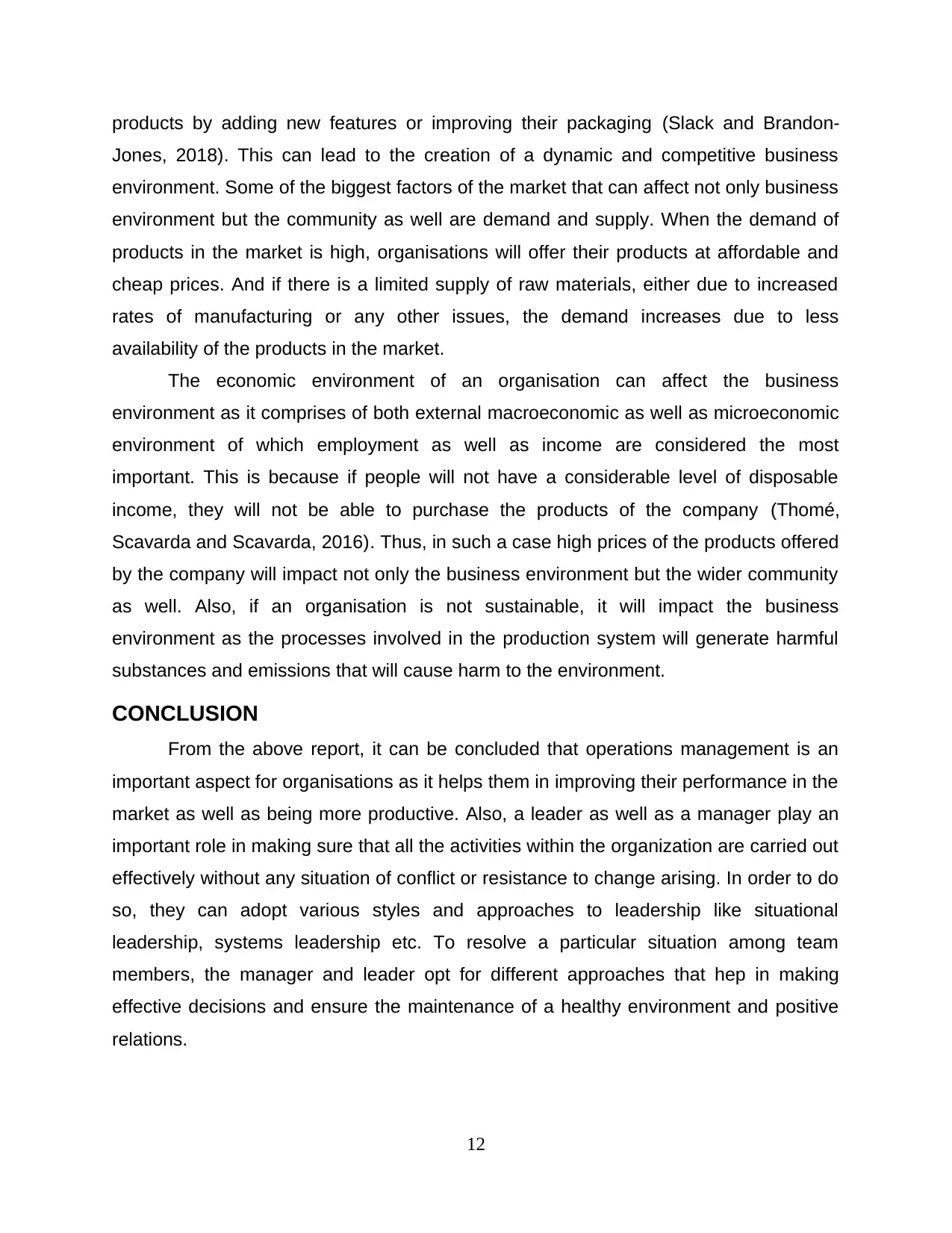
products by adding new features or improving their packaging (Slack and Brandon-
Jones, 2018). This can lead to the creation of a dynamic and competitive business
environment. Some of the biggest factors of the market that can affect not only business
environment but the community as well are demand and supply. When the demand of
products in the market is high, organisations will offer their products at affordable and
cheap prices. And if there is a limited supply of raw materials, either due to increased
rates of manufacturing or any other issues, the demand increases due to less
availability of the products in the market.
The economic environment of an organisation can affect the business
environment as it comprises of both external macroeconomic as well as microeconomic
environment of which employment as well as income are considered the most
important. This is because if people will not have a considerable level of disposable
income, they will not be able to purchase the products of the company (Thomé,
Scavarda and Scavarda, 2016). Thus, in such a case high prices of the products offered
by the company will impact not only the business environment but the wider community
as well. Also, if an organisation is not sustainable, it will impact the business
environment as the processes involved in the production system will generate harmful
substances and emissions that will cause harm to the environment.
CONCLUSION
From the above report, it can be concluded that operations management is an
important aspect for organisations as it helps them in improving their performance in the
market as well as being more productive. Also, a leader as well as a manager play an
important role in making sure that all the activities within the organization are carried out
effectively without any situation of conflict or resistance to change arising. In order to do
so, they can adopt various styles and approaches to leadership like situational
leadership, systems leadership etc. To resolve a particular situation among team
members, the manager and leader opt for different approaches that hep in making
effective decisions and ensure the maintenance of a healthy environment and positive
relations.
12
Jones, 2018). This can lead to the creation of a dynamic and competitive business
environment. Some of the biggest factors of the market that can affect not only business
environment but the community as well are demand and supply. When the demand of
products in the market is high, organisations will offer their products at affordable and
cheap prices. And if there is a limited supply of raw materials, either due to increased
rates of manufacturing or any other issues, the demand increases due to less
availability of the products in the market.
The economic environment of an organisation can affect the business
environment as it comprises of both external macroeconomic as well as microeconomic
environment of which employment as well as income are considered the most
important. This is because if people will not have a considerable level of disposable
income, they will not be able to purchase the products of the company (Thomé,
Scavarda and Scavarda, 2016). Thus, in such a case high prices of the products offered
by the company will impact not only the business environment but the wider community
as well. Also, if an organisation is not sustainable, it will impact the business
environment as the processes involved in the production system will generate harmful
substances and emissions that will cause harm to the environment.
CONCLUSION
From the above report, it can be concluded that operations management is an
important aspect for organisations as it helps them in improving their performance in the
market as well as being more productive. Also, a leader as well as a manager play an
important role in making sure that all the activities within the organization are carried out
effectively without any situation of conflict or resistance to change arising. In order to do
so, they can adopt various styles and approaches to leadership like situational
leadership, systems leadership etc. To resolve a particular situation among team
members, the manager and leader opt for different approaches that hep in making
effective decisions and ensure the maintenance of a healthy environment and positive
relations.
12
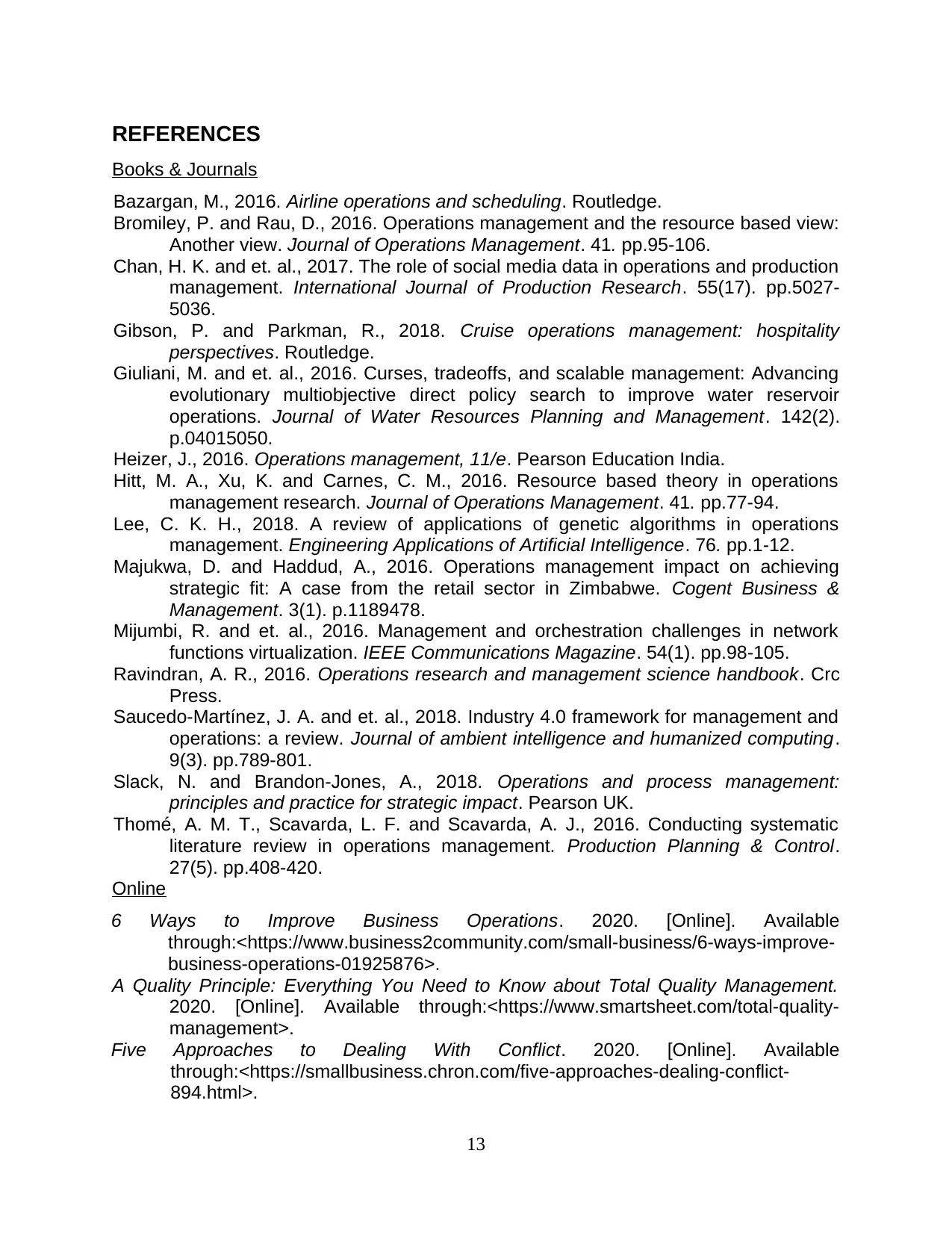
REFERENCES
Books & Journals
Bazargan, M., 2016. Airline operations and scheduling. Routledge.
Bromiley, P. and Rau, D., 2016. Operations management and the resource based view:
Another view. Journal of Operations Management. 41. pp.95-106.
Chan, H. K. and et. al., 2017. The role of social media data in operations and production
management. International Journal of Production Research. 55(17). pp.5027-
5036.
Gibson, P. and Parkman, R., 2018. Cruise operations management: hospitality
perspectives. Routledge.
Giuliani, M. and et. al., 2016. Curses, tradeoffs, and scalable management: Advancing
evolutionary multiobjective direct policy search to improve water reservoir
operations. Journal of Water Resources Planning and Management. 142(2).
p.04015050.
Heizer, J., 2016. Operations management, 11/e. Pearson Education India.
Hitt, M. A., Xu, K. and Carnes, C. M., 2016. Resource based theory in operations
management research. Journal of Operations Management. 41. pp.77-94.
Lee, C. K. H., 2018. A review of applications of genetic algorithms in operations
management. Engineering Applications of Artificial Intelligence. 76. pp.1-12.
Majukwa, D. and Haddud, A., 2016. Operations management impact on achieving
strategic fit: A case from the retail sector in Zimbabwe. Cogent Business &
Management. 3(1). p.1189478.
Mijumbi, R. and et. al., 2016. Management and orchestration challenges in network
functions virtualization. IEEE Communications Magazine. 54(1). pp.98-105.
Ravindran, A. R., 2016. Operations research and management science handbook. Crc
Press.
Saucedo-Martínez, J. A. and et. al., 2018. Industry 4.0 framework for management and
operations: a review. Journal of ambient intelligence and humanized computing.
9(3). pp.789-801.
Slack, N. and Brandon-Jones, A., 2018. Operations and process management:
principles and practice for strategic impact. Pearson UK.
Thomé, A. M. T., Scavarda, L. F. and Scavarda, A. J., 2016. Conducting systematic
literature review in operations management. Production Planning & Control.
27(5). pp.408-420.
Online
6 Ways to Improve Business Operations. 2020. [Online]. Available
through:<https://www.business2community.com/small-business/6-ways-improve-
business-operations-01925876>.
A Quality Principle: Everything You Need to Know about Total Quality Management.
2020. [Online]. Available through:<https://www.smartsheet.com/total-quality-
management>.
Five Approaches to Dealing With Conflict. 2020. [Online]. Available
through:<https://smallbusiness.chron.com/five-approaches-dealing-conflict-
894.html>.
13
Books & Journals
Bazargan, M., 2016. Airline operations and scheduling. Routledge.
Bromiley, P. and Rau, D., 2016. Operations management and the resource based view:
Another view. Journal of Operations Management. 41. pp.95-106.
Chan, H. K. and et. al., 2017. The role of social media data in operations and production
management. International Journal of Production Research. 55(17). pp.5027-
5036.
Gibson, P. and Parkman, R., 2018. Cruise operations management: hospitality
perspectives. Routledge.
Giuliani, M. and et. al., 2016. Curses, tradeoffs, and scalable management: Advancing
evolutionary multiobjective direct policy search to improve water reservoir
operations. Journal of Water Resources Planning and Management. 142(2).
p.04015050.
Heizer, J., 2016. Operations management, 11/e. Pearson Education India.
Hitt, M. A., Xu, K. and Carnes, C. M., 2016. Resource based theory in operations
management research. Journal of Operations Management. 41. pp.77-94.
Lee, C. K. H., 2018. A review of applications of genetic algorithms in operations
management. Engineering Applications of Artificial Intelligence. 76. pp.1-12.
Majukwa, D. and Haddud, A., 2016. Operations management impact on achieving
strategic fit: A case from the retail sector in Zimbabwe. Cogent Business &
Management. 3(1). p.1189478.
Mijumbi, R. and et. al., 2016. Management and orchestration challenges in network
functions virtualization. IEEE Communications Magazine. 54(1). pp.98-105.
Ravindran, A. R., 2016. Operations research and management science handbook. Crc
Press.
Saucedo-Martínez, J. A. and et. al., 2018. Industry 4.0 framework for management and
operations: a review. Journal of ambient intelligence and humanized computing.
9(3). pp.789-801.
Slack, N. and Brandon-Jones, A., 2018. Operations and process management:
principles and practice for strategic impact. Pearson UK.
Thomé, A. M. T., Scavarda, L. F. and Scavarda, A. J., 2016. Conducting systematic
literature review in operations management. Production Planning & Control.
27(5). pp.408-420.
Online
6 Ways to Improve Business Operations. 2020. [Online]. Available
through:<https://www.business2community.com/small-business/6-ways-improve-
business-operations-01925876>.
A Quality Principle: Everything You Need to Know about Total Quality Management.
2020. [Online]. Available through:<https://www.smartsheet.com/total-quality-
management>.
Five Approaches to Dealing With Conflict. 2020. [Online]. Available
through:<https://smallbusiness.chron.com/five-approaches-dealing-conflict-
894.html>.
13
Paraphrase This Document
Need a fresh take? Get an instant paraphrase of this document with our AI Paraphraser
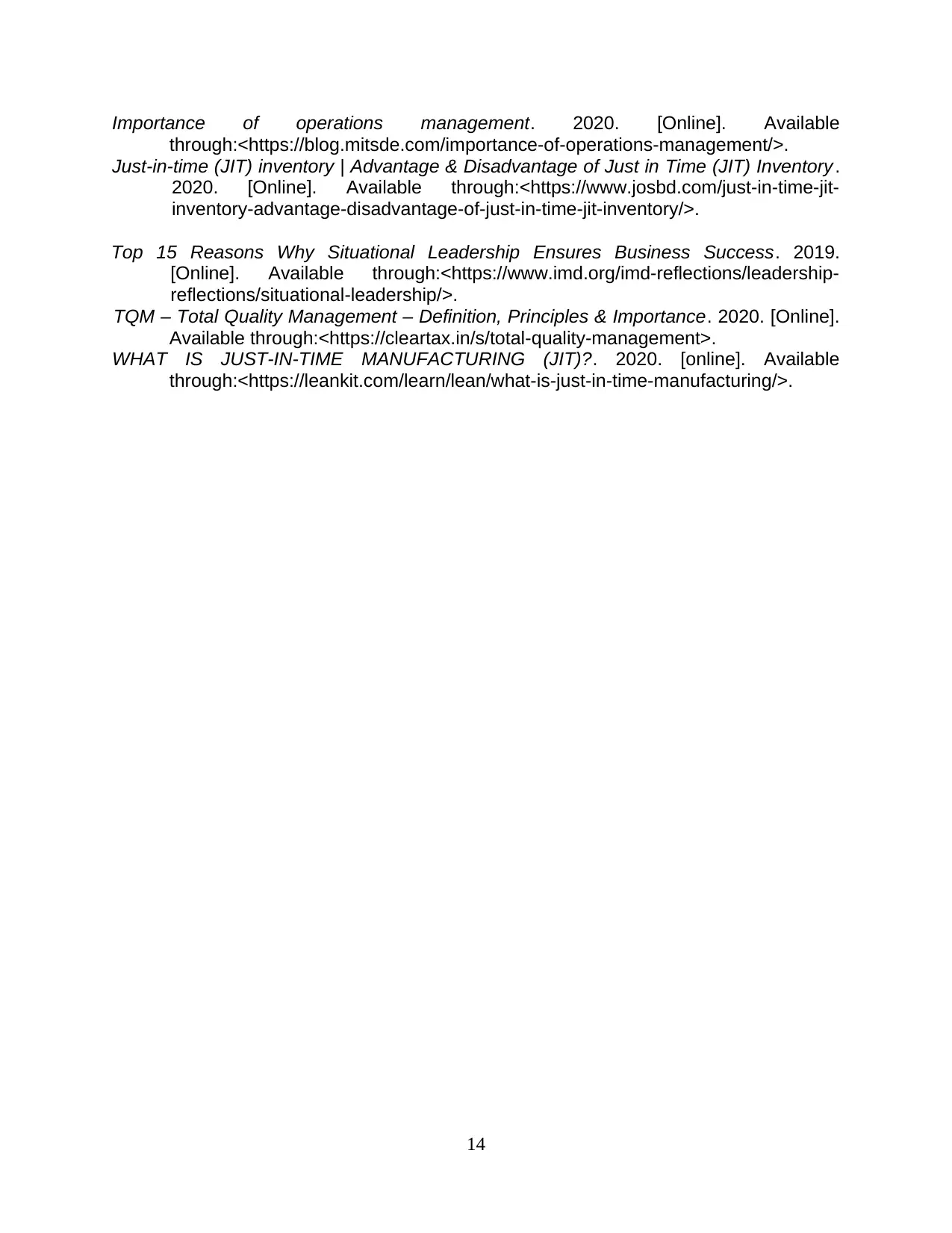
Importance of operations management. 2020. [Online]. Available
through:<https://blog.mitsde.com/importance-of-operations-management/>.
Just-in-time (JIT) inventory | Advantage & Disadvantage of Just in Time (JIT) Inventory .
2020. [Online]. Available through:<https://www.josbd.com/just-in-time-jit-
inventory-advantage-disadvantage-of-just-in-time-jit-inventory/>.
Top 15 Reasons Why Situational Leadership Ensures Business Success. 2019.
[Online]. Available through:<https://www.imd.org/imd-reflections/leadership-
reflections/situational-leadership/>.
TQM – Total Quality Management – Definition, Principles & Importance. 2020. [Online].
Available through:<https://cleartax.in/s/total-quality-management>.
WHAT IS JUST-IN-TIME MANUFACTURING (JIT)?. 2020. [online]. Available
through:<https://leankit.com/learn/lean/what-is-just-in-time-manufacturing/>.
14
through:<https://blog.mitsde.com/importance-of-operations-management/>.
Just-in-time (JIT) inventory | Advantage & Disadvantage of Just in Time (JIT) Inventory .
2020. [Online]. Available through:<https://www.josbd.com/just-in-time-jit-
inventory-advantage-disadvantage-of-just-in-time-jit-inventory/>.
Top 15 Reasons Why Situational Leadership Ensures Business Success. 2019.
[Online]. Available through:<https://www.imd.org/imd-reflections/leadership-
reflections/situational-leadership/>.
TQM – Total Quality Management – Definition, Principles & Importance. 2020. [Online].
Available through:<https://cleartax.in/s/total-quality-management>.
WHAT IS JUST-IN-TIME MANUFACTURING (JIT)?. 2020. [online]. Available
through:<https://leankit.com/learn/lean/what-is-just-in-time-manufacturing/>.
14
1 out of 14
Related Documents
Your All-in-One AI-Powered Toolkit for Academic Success.
+13062052269
info@desklib.com
Available 24*7 on WhatsApp / Email
![[object Object]](/_next/static/media/star-bottom.7253800d.svg)
Unlock your academic potential
© 2024 | Zucol Services PVT LTD | All rights reserved.





